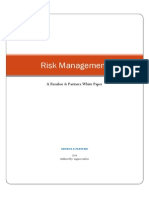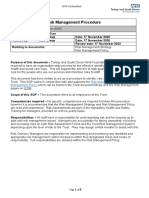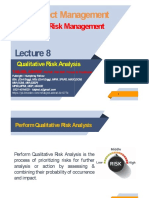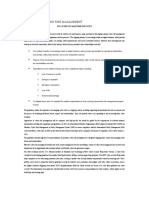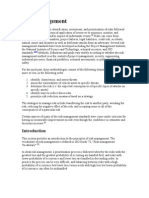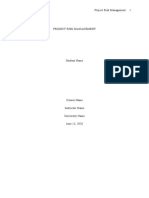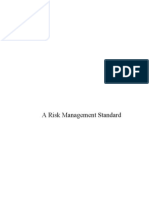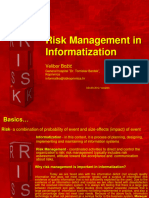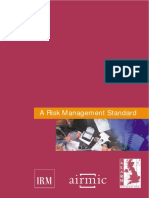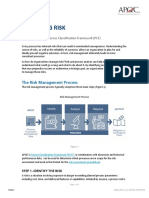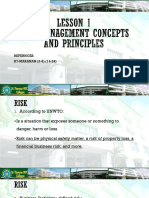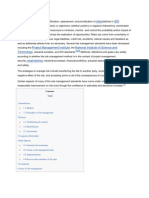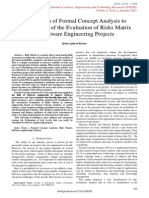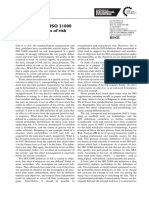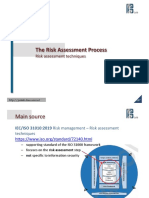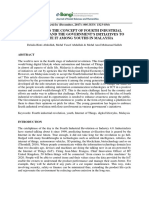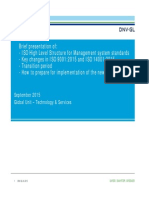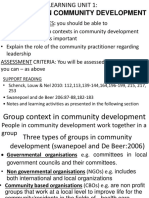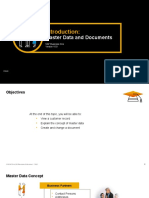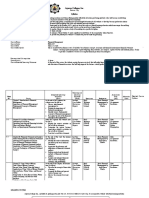Aleksandar Aleksić, Branislav Jeremić, Miladin Stefanović, Marko Đapan Abstract: One of The Keys of Successful Business Last Few
Aleksandar Aleksić, Branislav Jeremić, Miladin Stefanović, Marko Đapan Abstract: One of The Keys of Successful Business Last Few
Uploaded by
Darren TanCopyright:
Available Formats
Aleksandar Aleksić, Branislav Jeremić, Miladin Stefanović, Marko Đapan Abstract: One of The Keys of Successful Business Last Few
Aleksandar Aleksić, Branislav Jeremić, Miladin Stefanović, Marko Đapan Abstract: One of The Keys of Successful Business Last Few
Uploaded by
Darren TanOriginal Description:
Original Title
Copyright
Available Formats
Share this document
Did you find this document useful?
Is this content inappropriate?
Copyright:
Available Formats
Aleksandar Aleksić, Branislav Jeremić, Miladin Stefanović, Marko Đapan Abstract: One of The Keys of Successful Business Last Few
Aleksandar Aleksić, Branislav Jeremić, Miladin Stefanović, Marko Đapan Abstract: One of The Keys of Successful Business Last Few
Uploaded by
Darren TanCopyright:
Available Formats
International Journal for Quality research
UDK- 378.014.3(497.11)
Short Scientific Paper (1.03)
Risk Management Processes in Supply Chains
Abstract: One of the keys of successful business last few
Aleksandar Aleksić,
years is effective dealing with risks in every meaning of
Branislav Jeremić,
that word. At the time when the world economic crisis
Miladin Stefanović,
largely limits business, successful Risk management is the
Marko Đapan
only way of survival for a large number of business
systems. This paper will present the processes of risk
Faculty of Mechanical
management in supply chains that are in accordance with
Engineering, University of
the standards ISO 28000 and ISO 31000. By implementing
Kragujevac, Serbia
a holistic, enterprise-wide supply chain risk management
program, companies also can uphold their commitment to
providing strong corporate governance on behalf of
stakeholders and increase their market value.
Keywords: Risk management, Supply chains issues, Risk
treatment
1. INTRODUCTION organizational goals, business systems aim to
fully understand all the events and uncertainty
Risk management (RM) is a process that that could affect any point in the supply chain.
considers every reasonable activities of man
and we can say that it exists from the moment
when the man started to decide, plan and 2. DEFINING PROCESSES
execute various activities, as an individual or
the wider human community. Implementation Business information flows should be
of RM in the supply chains is an area with great integrated in a way that is consistent
potential for practical work and presents field regulations, standardization and harmonization.
where can be achieved significant results. Integration of reporting mechanisms during the
According to Christopher (1992) Supply process of risk management brings multiple
chain is network of organizations that are benefits, in addition to bring compliance of
involved, through upstream and downstream business processes and increase efficiency.
linkages, in the different processes and Risk management processes are identified by
activities that produce value in the form of standard ISO 31000.
products and services in the hands of the The supply chain organization should
ultimate consumer. [1] establish internal mechanisms of
Supply Chain Risk Management is a communication and reporting. They should
structured and synergetic process throughout include procedures for the consolidation of risk
the supply chain, which seeks to optimize the and information from different sources within
totality of strategy, processes, human resources, the organization.
technology and knowledge. The aim is to Organizations should also develop and
control, monitor and evaluate supply chain risk, implement a plan that will communicate with
which will serve to safeguard continuity and external stakeholders. [3]
maximize profitability. [2] In order to fulfill its
business goals, business systems are very
dependent on the partners in the supply chain
and the impact of any link in the supply chain.
In order to ensure the achievement of their
Vol.3, No. 2, 2009 1
risk identification, risk analysis and risk
evaluation.
2.3.1 Risk identification
It is often useful to consider categories of
risks as a starting point to guide organizations
in an initial assessment of their supply chains.
Many authors have their own opinion of
identifying Supply chain risks.
Thinking broadly, risks in supply chains can be
identified as:
• Organizational risk
• Network risk
• Environmental risk [4]
Figure 1 –Risk management processes
2.1 Communication and consultation
In the processes of risk management
communication and consultation with internal
and external interest parties should be present
in each phase as much as is necessary. Plan for
communication and consultation with internal
and external stakeholders should be developed
in the early stage. This plan should address Figure 2 – risks in supply chains
issues relating to the risk itself, its
consequences and answers to manage it. During Risks can be seen as internal or external to
the process of communication and consultation the focal firm, and be seen as internal or
with stakeholders it is important to bear in mind external to the supply chain[5]:
that they have opinions about the risk on the • Process risk
basis of their perception of risk. As their • Control risk
opinion may have a significant influence on the • Supply risk
decision, it is important to identify it, record • Demand risk
and take into account in the decision-making • Environmental risk
process.
2.2 Establishing the context
Establishing of context make organization
defines internal and external parameters that
should be taken into account in risk
management and the scope of risk and the
criteria for the process selection. Context
should be associating with internal and external
parameters relevant for the organization.
Figure 3 – risks in supply chains
2.3 Risk assessment
AMR Research is company that provides
Risk assessment is the overall process of
A. Aleksić, B.Jeremić, M. Stefanović, M. Đapan 2
comprehensive research and advisory services 2.3.2 Risk analysis
for supply chain and IT executives. AMR
Research regularly surveys global companies to Risk analysis involves consideration of the
measure the levels of risk in their global supply causes and sources of risk, their positive and
chains, gauge the regions that contribute the negative outcomes, and the likelihood that the
most significant risks, and analyze the impact consequences may appear. It is believed that
of these risks on how they manage their the risk is analyzed by determining the
business. Based on their research we can probability and its consequences.
conclude that importance of specific risk The way in which the consequences and
changes over time. The most significant risks in the probability are stated in order to determine
2006 were: the degree of risk, depends on the type of risk,
• Supplier failure (28%) available information and purpose of risk
• Strategic risk (17%) assessment output is carried out. It is also
• Natural disaster (15%) important to pay attention to the
• Geo-political events (11%) interdependence of the various risks and their
• Regulatory risk (11%) sources.
• Logistics failure (10%) It is possible to determine the
consequences of modeling the outcome as one
• Intellectual property infringement
event or events, or analyzing experimental
(7%)
studies or from available data.
• Other (1%) . [6]
Event may have multiple consequences
In the most recent survey, conducted in
that may affect more goals.
October 2008, AMR asked 130 global
The purpose of risk evaluation is a help in
companies about the risks that they face in their
decision-making, based on the results of the
supply chains. These are results: [7]
risk. Another objective is to define the priorities
of the treatment implementation based on the
Top three Supply Chain Risks (October
level of risk which need treatment. Risk
2008 survey results)
evaluation includes a comparison of the level of
RISK RANK Compared risk according to criteria that are taken during
to May the establishing the context. If the level of risk
2008 does not meet risk criteria, the risk should be
1 45% of the No change treated.
energy costs
respondents
Rising
identified this 2.4 Risk treatment
risk as the top
risk Risk treatment is the process of identifying
2 42% of the
The level opportunities for treatment and control. The
goal of this activity is finding ways to reduce or
transportation
respondents
of risk
identified this
went eliminate negative consequences and reducing
Rising
costs
risk as the top
down by 9 the occurrence of negative probability. Risk
risk
points, treatment activities also aim to strengthen
51% to positive outcome of business processes. It’s
42% not often possible to implement all the
3 38% of the The level strategies of treatment or it’s not cost effective
price volatility
respondents of risk solution. Business owner or Board of Directors
Commodity
identified this went should decide what priorities in risk treatment
risk as the top down by 5 are and make the implementation of the most
risk points, relevant combination of risk treatment
43% to solutions.
38%
Table 1- Top Supply Chain Risks according 2.4.1 Early intervention approach
AMR research
Every company should focus on early
intervention rather than crisis management.
This supposes to be incorporated throughout
Vol.3, No. 2, 2009 3
the risk management structure. [8] This way of • Actual price
thinking does not include only policies, • Financial ability
procedures, and governance, it’s related to the • Technical performance
philosophy of the risk treatment by the whole • Delivery history
company. Basic characteristics of this approach • Technical assistance
are: • Production capability
• Essence of Risk assessment is • Manufacturing equipment.
aggregating and prioritizing leading After selection, there is a need to
risks and estimation of their constantly monitor and track the work of
probabilities and impact suppliers to do the evaluation. Most of the
• Risk response is based on comparing attention is needed to make these activities
this knowledge of risk to tolerance successful:
levels, company should react • Analysis of business environment
promptly suppliers
• Risk monitoring basis is evaluating • Permanent analysis of indicators of
the performance of risk treatment risk.
continuously as new informations If there is a need for corrective actions, the
become available company can bring in alternative suppliers
• The improvement is achieved by the which can be crucial in some occasions. One of
constant identification of the best explanations of this is case of Nokia
performance gaps and finding and Eriksson. Fire destroyed an electronics
solutions to overcome them. component plant in New Mexico in 2000.
Nokia Management team has reacted very
2.4.2 Dealing with top risks of Supply Chains quickly. They secured components from the
market and Eriksson was left with supply
Supplier failure- shortages which translated into lost sales
According to data from the 2006 estimated at $390M.
most significant risk in the supply chain was
Supplier failure. PricewaterhouseCoopers Rising energy and transportation costs-
discusses how supply chain disruption can As market conditions show that direction
destroy shareholder value and corporate of impact of rising energy costs isn't pointed to
profitability. Their opinion is that companies customers and suppliers but the manufacturing
must invest in enhancing the integrity of their companies, the reality becomes clear. High
supply chains, in a manner which balances costs of energy and material are reality and the
operational objectives and risk management. In manufacturing companies must take action in
today's business world there is a variety of their supply chain to maintain sustainability.
supplier relationships and different forms of
interconnection of supliers and the core
organisation. Because of obvious threats to
business of supply chain, it is necessary to keep
the work in accordance with the processes that
will reduce risks when selecting suppliers and
work with them.
Supplier selection is very important
operational decision. Company should align
business objectives with suppliers and establish
key risk indicators. It is appropriate that the
decision-making process of supplier selection is
based on the following criteria[9]:
• Quality personnel
• Quality procedure Better use of resources in logistics and
• Concern for quality transportation can be a certain help in solving
• Company history the problems of increased costs of fuel and
energy.
• Price relative to quality
During the implementation of risk
A. Aleksić, B.Jeremić, M. Stefanović, M. Đapan 4
treatment process successful companies have focusing at the current status or
come to certain solutions that were situation.
subsequently implemented. Examples of
actions taken to reduce or eliminate the risk
include: 3. CONCLUSION
• ensuring fully loaded transport
equipment In this paper, we have presented the main
• reduction in part load orders processes of risk management in supply chains.
• optimization of delivery frequency to We were analyising issues that were addressed
maximize full loads to main risks and we gave conclusions about
• consolidation of the number of their treatment processes.
suppliers By observing the world economy today it
• increased frequency of reviewing fuel is becoming increasingly clear that traditional
surcharges to support supplier’s viability supply chain management approaches must be
• reviewing and changing the total enhanced in way to become capable to deal
distribution network design to factor in with the new uncertainties and issues which are
increased fuel costs arising from new market trends.
A company that manages Supply Chain
• improving driver training to improve
efficiency of delivery costs versus shortest risks effectively has the advantage over the
delivery time. [10] competition. The Benefits of Managing Supply
Chain Risk are:
2.5 Monitoring and review • Better decisions making
• Better balance between opportunity
Monitoring and review is an ongoing part and threat
of risk management that is integral to every • Fewer surprises
step of the process. It is also the part of risk • Reducing costs
management that is most often given • Effective selection of suppliers.
inadequate focus and as consequence of that Even the best-organized supply chain can’t
programs of many agencies become ineffective expect to predict all future events and
over time. disruptions. However, proactive supply chain
This part of Risk management ensures that executives are trying to focus on optimizing
the important information generated by the decisions and processes across the entire supply
previous processes is captured, used, and chain in order to gain clear benefits. To deal
maintained. with supply chain impacts associated with
Distinctions between Monitoring and review various types of risks (uncertain consumer
are important in the context of risk demands, and unpredictable natural and man-
management: made disasters), many researchers have
• Monitoring is the ongoing process of developed different strategies for managing
oversight of internal and external supply chain risks.
environment. .
• Review is a process that is described
as more periodic process that is
REFERENCES:
[1] Christopher, M., (1992), Logistics and Supply Chain Management. Pitman, London.
[2] The brochure “Supply Chain Risk Management - Better control of your business
environment, (June 2004), Deloitte
[3] ISO/DIS 31000
[4] Jütner, U., Peck, H. and Christopher, M. (2003), Supply Chain Risk Management:
Outlining an Agenda for Future Research. International Journal of Logistics: Research
and Applications, Vol. 6, No. 4, pp. 197-210.
Vol.3, No. 2, 2009 5
[5] Peck, H. (2003), Supply Chain Resilience, UK Department of Transport/ Cranfield
University, Cranfield, UK.
[6] Robert Malone, (November 2006), Worst Supply Chain Risks, www.forbes.com
[7] Noha Tohamy, (November2008), Managing the Biggest Supply Chain Risk of All:
Constant Change, AMR Research
[8] PricewaterhouseCoopers interview (December 2009), From vulnerable to valuable: how
integrity can transform a supply chain
[9] Moskowitz, H., Tang, J., and Lam, P. (2000). Distribution of aggregate utility using
stochastic elements of additive multiattribute utility models, Decision Sciences 31, 327–
360.
[10] Df Helge Koenig/Manneheim, www.icis.com | December 1-7, (2008), ICIS Chemical
Business
A. Aleksić, B.Jeremić, M. Stefanović, M. Đapan 6
You might also like
- CISM Chapter2-Info Risk MGMT - ComplianceDocument70 pagesCISM Chapter2-Info Risk MGMT - ComplianceLakshmiNo ratings yet
- Financial Risk ManagementDocument21 pagesFinancial Risk ManagementLianne Esco100% (5)
- Ioannis Tsiouras - The risk management according to the standard ISO 31000From EverandIoannis Tsiouras - The risk management according to the standard ISO 31000Rating: 3 out of 5 stars3/5 (1)
- Risk Management - 2013Document57 pagesRisk Management - 2013newmetroNo ratings yet
- Risk ManagementDocument14 pagesRisk Managementbradsean1350No ratings yet
- Risk Assessment and Identifications The Pivot of Risk Management in An Organization.Document18 pagesRisk Assessment and Identifications The Pivot of Risk Management in An Organization.enbassey100% (1)
- Risk Management (Article)Document15 pagesRisk Management (Article)kanakarao1No ratings yet
- Cariflex IR Latex - Wet Gel StrengthDocument7 pagesCariflex IR Latex - Wet Gel StrengthDarren TanNo ratings yet
- Platform User ManualDocument15 pagesPlatform User ManualJuan Brito100% (3)
- Risk ManagementDocument14 pagesRisk ManagementMateta Elie100% (2)
- Risk Assessment and Risk MappingDocument7 pagesRisk Assessment and Risk MappingAJER JOURNALNo ratings yet
- Risk Management SopDocument8 pagesRisk Management SopLi QiNo ratings yet
- Risk Management SopDocument8 pagesRisk Management SopLi QiNo ratings yet
- PGPM31 M57Document29 pagesPGPM31 M57Shelly DelhiNo ratings yet
- A Model To Assess The Maturity Level of The Risk Management Process in Information SecurityDocument10 pagesA Model To Assess The Maturity Level of The Risk Management Process in Information SecurityHery Sapto Dwi NurcahyoNo ratings yet
- Week 4Document18 pagesWeek 4mfarrukhfbNo ratings yet
- Research On Risk Evaluation in Supply Chain Based On Grey Relational MethodDocument8 pagesResearch On Risk Evaluation in Supply Chain Based On Grey Relational MethodIvelina AngelovaNo ratings yet
- RMS FermaDocument16 pagesRMS Fermafinka52No ratings yet
- Hazard Identification and Risk Assessment With Controls (Hirac) in OilDocument5 pagesHazard Identification and Risk Assessment With Controls (Hirac) in OilJustamacacaNo ratings yet
- Supply Chain Risk Management Concept... Presentation 2nd SemDocument29 pagesSupply Chain Risk Management Concept... Presentation 2nd SemIsaac Tetteh CharnorNo ratings yet
- Risk Management ProcedureDocument8 pagesRisk Management Procedureyaseen mosaNo ratings yet
- Risk ManagementDocument12 pagesRisk ManagementSubodh Kumar0% (1)
- Risk Management Section 1Document43 pagesRisk Management Section 1ayariseifallah100% (1)
- Risk Management Is The Identification, Evaluation, and Prioritization ofDocument5 pagesRisk Management Is The Identification, Evaluation, and Prioritization ofGowrisanthosh PalikaNo ratings yet
- Risk Management Is The Identification, Evaluation, and Prioritization ofDocument8 pagesRisk Management Is The Identification, Evaluation, and Prioritization ofkubs arainNo ratings yet
- Project Risk ManagementDocument29 pagesProject Risk ManagementIjlal NasirNo ratings yet
- Fang A Simultation-BasedDocument10 pagesFang A Simultation-Basedmichael17ph2003No ratings yet
- CybersecurityDocument8 pagesCybersecurityNani InfinityNo ratings yet
- Public Service ICT Risk Management Toolkit GuideDocument12 pagesPublic Service ICT Risk Management Toolkit GuideNathanNo ratings yet
- Risk ManagementDocument10 pagesRisk Managementlove0lust67% (3)
- IISITv6p595 615nikolic673 PDFDocument21 pagesIISITv6p595 615nikolic673 PDFJack MisterouffeNo ratings yet
- Project Risk Management2Document15 pagesProject Risk Management2Aayush GargNo ratings yet
- Risk Management SystemDocument13 pagesRisk Management SystemRahiana AminNo ratings yet
- Supply Chain RiskDocument4 pagesSupply Chain RiskNavi SinghNo ratings yet
- IT Risk Assessment: Quantitative and Qualitative Approach: Artur RotDocument6 pagesIT Risk Assessment: Quantitative and Qualitative Approach: Artur RotwvqhjdvwjqNo ratings yet
- Riskmanagement ProcessDocument61 pagesRiskmanagement ProcessNugi DragneelNo ratings yet
- Identification and Management of Risks in Construction ProjectsDocument8 pagesIdentification and Management of Risks in Construction ProjectsPrasanthi KoneruNo ratings yet
- Risk Management Standard 030820Document18 pagesRisk Management Standard 030820complete9jbNo ratings yet
- Risk Managementin InformatizationDocument12 pagesRisk Managementin InformatizationcherifdjNo ratings yet
- Lesson 1 Risk Management Concepts and PrinciplesDocument24 pagesLesson 1 Risk Management Concepts and PrinciplesShaina Tancio Abanid100% (1)
- Proven Approaches To Procurement Risk Management: A Framework Review and Case Study of ISO 31000Document11 pagesProven Approaches To Procurement Risk Management: A Framework Review and Case Study of ISO 31000Imane SassaouiNo ratings yet
- Risk Management Framework System Development GuidelinesDocument14 pagesRisk Management Framework System Development Guidelinesعبدالمعز المليان100% (1)
- A Risk Management StandardDocument17 pagesA Risk Management StandardBosko100% (2)
- Post-Mortem Analysis On The Analysis and Evaluatio ModifyDocument9 pagesPost-Mortem Analysis On The Analysis and Evaluatio ModifyMatthieu PotesNo ratings yet
- K08340 - Managing Risk - How To Use A Process Classification FrameworkDocument4 pagesK08340 - Managing Risk - How To Use A Process Classification FrameworkR ALSHEHRINo ratings yet
- Refernces: R7-MARANAN (3-5) (14-24)Document18 pagesRefernces: R7-MARANAN (3-5) (14-24)Mayang YamashitaNo ratings yet
- Unit - %Document14 pagesUnit - %402 ABHINAYA KEERTHINo ratings yet
- A Risk Management StandardDocument17 pagesA Risk Management StandardSachi Anand100% (2)
- Risk ManagementDocument20 pagesRisk ManagementZHNo ratings yet
- Risk Management - L-20Document22 pagesRisk Management - L-20নয়ন দেবনাথNo ratings yet
- 1-2-Department of Procurement and Supplychain ManagementDocument12 pages1-2-Department of Procurement and Supplychain ManagementHenry dragoNo ratings yet
- AIRMICDocument14 pagesAIRMICMartin UribeNo ratings yet
- Risks ISO 31000: C Is The Identification, Assessment, and Prioritization ofDocument14 pagesRisks ISO 31000: C Is The Identification, Assessment, and Prioritization ofgoodarshNo ratings yet
- Risk Management - Concepts and ApplicationsDocument20 pagesRisk Management - Concepts and ApplicationsStephen EmmanuelNo ratings yet
- تحليل المخاطر بمشروع المنارة للاتصالاتDocument23 pagesتحليل المخاطر بمشروع المنارة للاتصالاتSuleiman BaruniNo ratings yet
- Application of Formal Concept AnalysisDocument6 pagesApplication of Formal Concept AnalysisJayaletchumi MoorthyNo ratings yet
- Orange Book Management of RiskDocument48 pagesOrange Book Management of RiskNelson LimaNo ratings yet
- Foundations of Quality Risk Management: A Practical Approach to Effective Risk-Based ThinkingFrom EverandFoundations of Quality Risk Management: A Practical Approach to Effective Risk-Based ThinkingNo ratings yet
- The Simple Rules of Risk: Revisiting the Art of Financial Risk ManagementFrom EverandThe Simple Rules of Risk: Revisiting the Art of Financial Risk ManagementNo ratings yet
- Adventurer's Guide to Risk Management: Fictional Tales about Risk ManagementFrom EverandAdventurer's Guide to Risk Management: Fictional Tales about Risk ManagementNo ratings yet
- GCU Research and Project Risk Register Template (GOOD1)Document3 pagesGCU Research and Project Risk Register Template (GOOD1)Darren TanNo ratings yet
- The Flaws of The ISO 31000 Conceptualisation of RiskDocument2 pagesThe Flaws of The ISO 31000 Conceptualisation of RiskDarren TanNo ratings yet
- Sunway Construction Group Berhad: Terms of Reference of Nomination and Remuneration CommitteeDocument4 pagesSunway Construction Group Berhad: Terms of Reference of Nomination and Remuneration CommitteeDarren TanNo ratings yet
- 04RM - Risk-Assessment 2Document32 pages04RM - Risk-Assessment 2Darren TanNo ratings yet
- Real-World Examples of Risk AssessmentDocument17 pagesReal-World Examples of Risk AssessmentDarren TanNo ratings yet
- 3.4 Supporting Doc Risk Register Template With InstructionsDocument8 pages3.4 Supporting Doc Risk Register Template With InstructionsDarren TanNo ratings yet
- 05RM Risk-TreatmentDocument10 pages05RM Risk-TreatmentDarren TanNo ratings yet
- A Review On The Concept of Fourth Industrial Revolution and The Government'S Initiatives To Promote It Among Youths in MalaysiaDocument8 pagesA Review On The Concept of Fourth Industrial Revolution and The Government'S Initiatives To Promote It Among Youths in MalaysiaDarren TanNo ratings yet
- ESG - Ey-Cbm-Unlocking-Esg-Strategic-ValueDocument9 pagesESG - Ey-Cbm-Unlocking-Esg-Strategic-ValueDarren TanNo ratings yet
- Environmental, Social and Governance: How Companies Could Respond To ESG DevelopmentDocument2 pagesEnvironmental, Social and Governance: How Companies Could Respond To ESG DevelopmentDarren TanNo ratings yet
- HLS and ISO 9001 - ISO 14001 - Key Changes and Transition (September 2015) - tcm8-12652Document18 pagesHLS and ISO 9001 - ISO 14001 - Key Changes and Transition (September 2015) - tcm8-12652KumaravelNo ratings yet
- Lai 1991 Viscosity Latex MixesDocument10 pagesLai 1991 Viscosity Latex MixesDarren TanNo ratings yet
- Riginal Rticles Total Productive Maintenance Application To Reduce Defects of ProductDocument7 pagesRiginal Rticles Total Productive Maintenance Application To Reduce Defects of ProductDarren TanNo ratings yet
- Cyatex Nk-220: NBR Latex For GlovesDocument4 pagesCyatex Nk-220: NBR Latex For GlovesDarren TanNo ratings yet
- Arbitradex PDFDocument12 pagesArbitradex PDFSindhu ThomasNo ratings yet
- LU 2 Leadership in CD IntroDocument7 pagesLU 2 Leadership in CD IntromiracleNo ratings yet
- Master Data and Documents: SAP Business OneDocument15 pagesMaster Data and Documents: SAP Business OneChadwick E VanieNo ratings yet
- Scenario-Based AssessmentDocument2 pagesScenario-Based AssessmentThabiso MathobelaNo ratings yet
- Fintech Chapter 1Document30 pagesFintech Chapter 1shamira haqueNo ratings yet
- Agusan Colleges, Inc: SyllabusDocument3 pagesAgusan Colleges, Inc: SyllabusAdrian Perolino DelosoNo ratings yet
- Perry Casestudy6Document5 pagesPerry Casestudy6Zee H.No ratings yet
- E-Banking and Customer Satisfaction in Commercial Banks A Case of Centenary Bank Main Branch-Mapeera House of UgandaDocument16 pagesE-Banking and Customer Satisfaction in Commercial Banks A Case of Centenary Bank Main Branch-Mapeera House of UgandaKIU PUBLICATION AND EXTENSIONNo ratings yet
- Jetblue Airlines: Monica Agrippa MARCH 18, 2013 Jetblue Case Study AnalysisDocument48 pagesJetblue Airlines: Monica Agrippa MARCH 18, 2013 Jetblue Case Study AnalysisVishal Kumar SinghNo ratings yet
- Schön in Building Global International Tax Law (2022) 243Document18 pagesSchön in Building Global International Tax Law (2022) 243Selcen CenikogluNo ratings yet
- Ei-Xxx Gouri Sap#80001434 CVDocument9 pagesEi-Xxx Gouri Sap#80001434 CVNimra RizwanNo ratings yet
- Project Topics Project NoDocument3 pagesProject Topics Project No1442014-15No ratings yet
- E.O. No. 180Document2 pagesE.O. No. 180Ron VillanuevaNo ratings yet
- Introduction - The Spiral ModelDocument7 pagesIntroduction - The Spiral ModelAaron LeeNo ratings yet
- Personal Finance ActivitiesDocument32 pagesPersonal Finance ActivitiesRonald CatapangNo ratings yet
- IT Project Delivery - Agile & DEVOPS (10042024)Document39 pagesIT Project Delivery - Agile & DEVOPS (10042024)Shashwat JhaNo ratings yet
- Presentation ON Bajaj Group: BY:-Aakriti Verma Abhinav Pathania Bhisham Padha Presented To: - Prof. Alka SharmaDocument25 pagesPresentation ON Bajaj Group: BY:-Aakriti Verma Abhinav Pathania Bhisham Padha Presented To: - Prof. Alka SharmaPankaj DograNo ratings yet
- PM - Class - Change (Training Manual) : Project Name: IMSS Implementation at UPRVUNL Project ID: 6820-02Document9 pagesPM - Class - Change (Training Manual) : Project Name: IMSS Implementation at UPRVUNL Project ID: 6820-02150819850No ratings yet
- Clean Room CatalogueDocument20 pagesClean Room CatalogueKISHANSINGH YADAVNo ratings yet
- CPWD REPORT - RemovedDocument15 pagesCPWD REPORT - RemovedMANISH KHARWARNo ratings yet
- Indian Accounting Standard 12: © The Institute of Chartered Accountants of IndiaDocument22 pagesIndian Accounting Standard 12: © The Institute of Chartered Accountants of IndiaRITZ BROWNNo ratings yet
- HandbookDocument30 pagesHandbookannqgbd201509No ratings yet
- Scenario Planning - Syndicate 6Document13 pagesScenario Planning - Syndicate 6Simon ErickNo ratings yet
- Unit IV - Develop A Business PlanDocument4 pagesUnit IV - Develop A Business PlanARIANE DOLINONo ratings yet
- Spring 2019 Intro To Agriculture Classroom Final ProjectDocument2 pagesSpring 2019 Intro To Agriculture Classroom Final Projectapi-341301555No ratings yet
- Marketing Is The Process of Exploring, Creating, and Delivering Value To Meet The Needs ofDocument8 pagesMarketing Is The Process of Exploring, Creating, and Delivering Value To Meet The Needs ofTrang HaNo ratings yet
- Answer Q 10 Pinkerton CaseDocument3 pagesAnswer Q 10 Pinkerton CaseSaswata BanerjeeNo ratings yet
- Mailing List For Medical Device CompaniesDocument4 pagesMailing List For Medical Device Companiesadhwaidh rkNo ratings yet
- Enbaling Out Comes 6 (Hbo)Document2 pagesEnbaling Out Comes 6 (Hbo)Nabongs AegyooNo ratings yet




